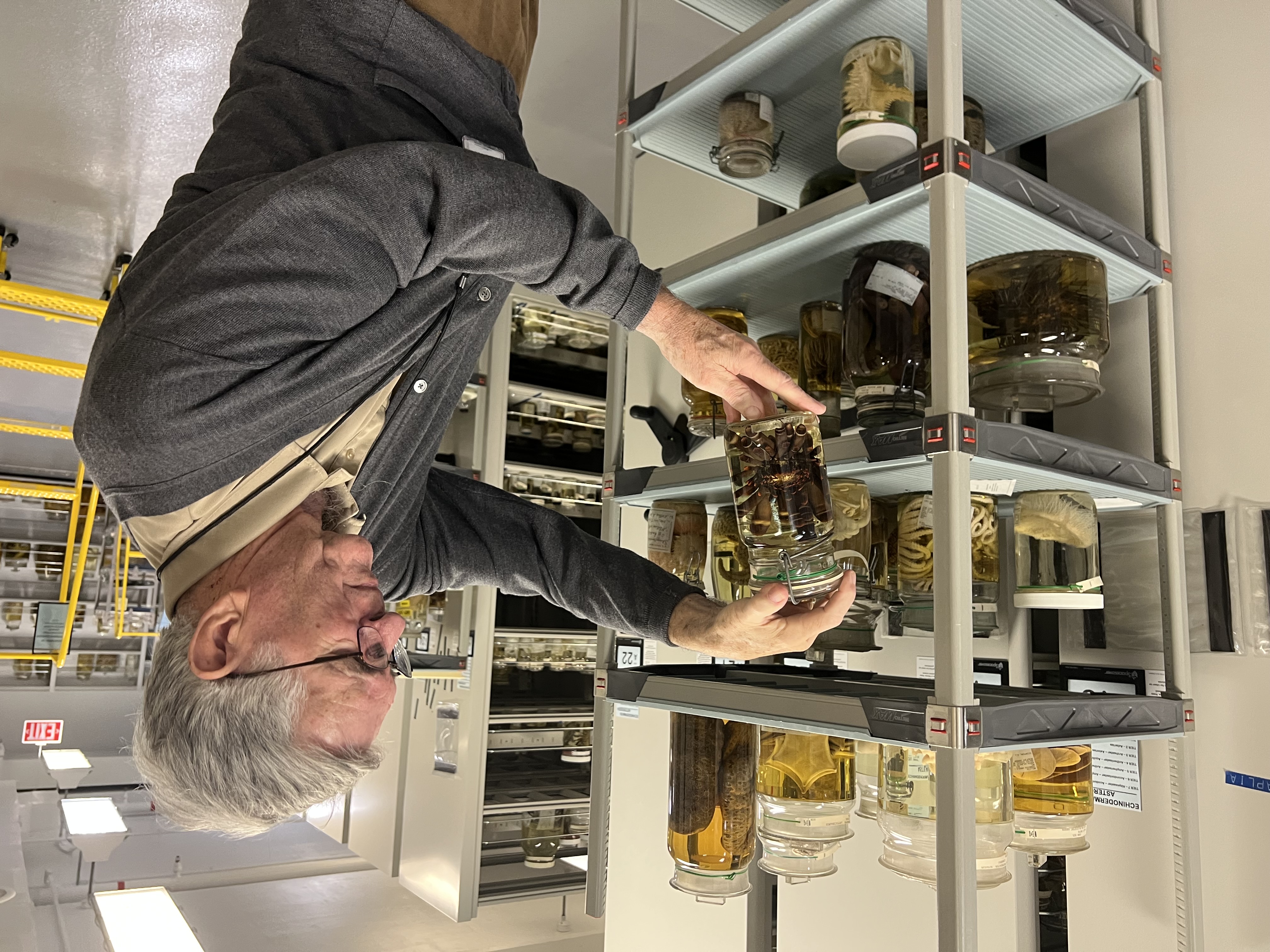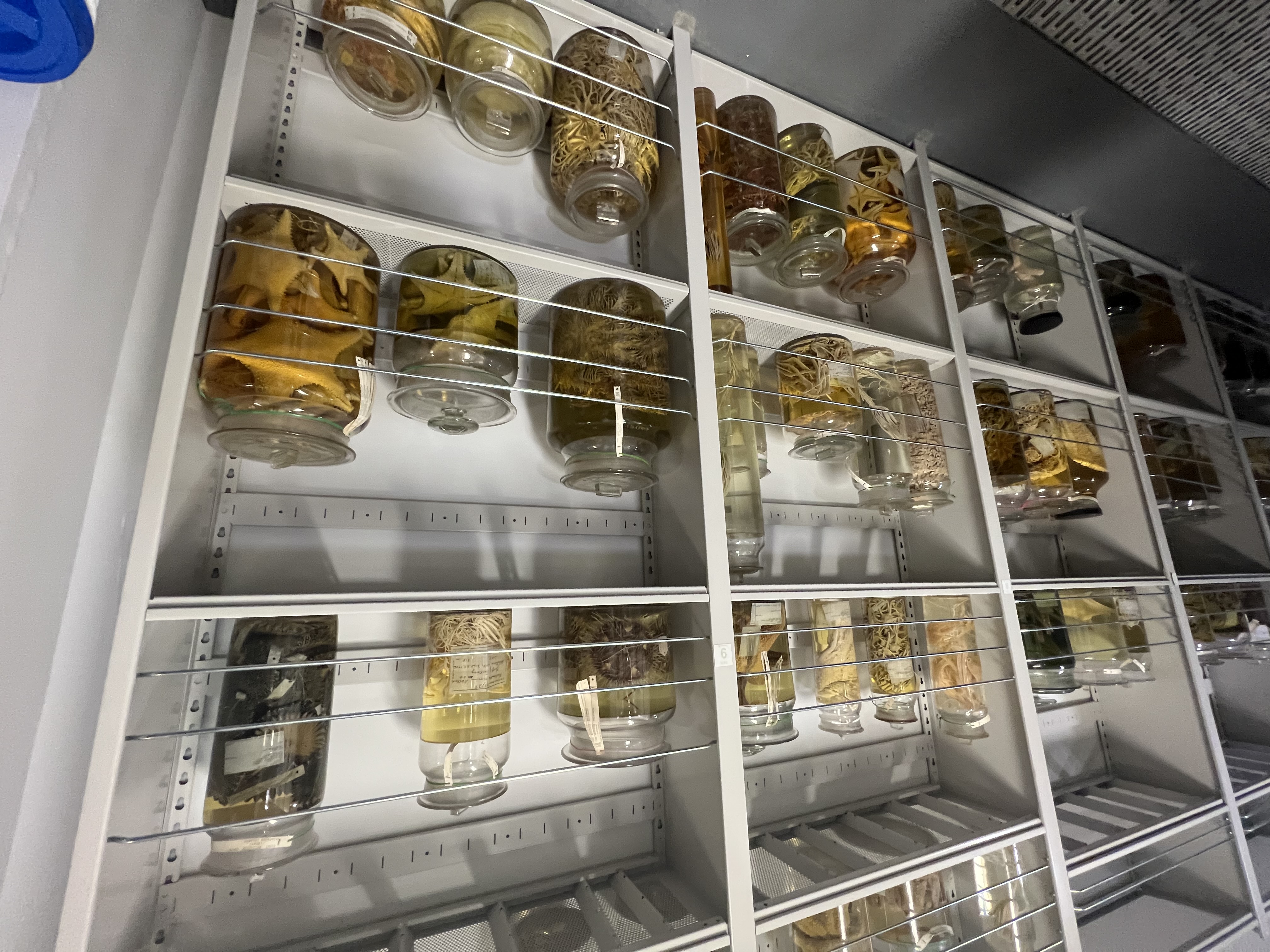NATIONAL MUSEUM OF NATURAL HISTORY
Meet the Smithsonian Scientist Who Has Spent Decades Exploring Ocean Depths
Marine biologist Dr. Dave Pawson has embarked on over 100 dives to the ocean floor to unravel the mysteries of elusive invertebrates like sea cucumbers and brittle stars
:focal(416x234:417x235)/https://tf-cmsv2-smithsonianmag-media.s3.amazonaws.com/filer_public/18/7a/187a229e-437c-4d16-9536-94117a1d1b56/pawsonaster_parvus2.jpg)
There are few people who have spent more time on the bottom of the ocean than Dave Pawson. This Smithsonian senior scientist has spent his career in pursuit of study subjects that live exclusively on sandy ocean floors. This has led him to traverse unknown ecosystems and encounter species that are entirely new to science.
While studying zoology at his native New Zealand’s Victoria University in Wellington, Pawson chose to focus his research on echinoderms, a group of marine invertebrates that includes sea stars, sea urchins, brittle stars, sea cucumbers and sea lilies. His research has taken him to the Galapagos Islands, the Caribbean, Australia, Bermuda and Antarctica, where he has pioneered deep-sea sampling techniques and gathered behavioral data on understudied species that had never been observed in their natural habitats.
After arriving at the National Museum of Natural History in 1964, Pawson meticulously cared for more than 500,000 echinoderm specimens as the museum’s Curator of Echinoderms. He served as both Acting Director and Associate Director for Science at the museum and is now a passionate Emeritus researcher committed to teaching the next generation of scientists about echinoderms.
/https://tf-cmsv2-smithsonianmag-media.s3.amazonaws.com/filer_public/f9/cc/f9cc6ed7-6232-4ee1-86df-b6177c69ada9/2009-12002-s.jpg)
Over an impressive six-decade career, Pawson has published more than 200 articles and book chapters, sponsored dozens of pre- and post-doctoral fellows and even had a mountain in Antarctica named after him. (This honor came as a surprise when he stumbled upon Mount Pawson online earlier this year. “I was shocked and very proud,” Pawson said with a laugh). Pawson’s family also became deeply dedicated to his work with echinoderms. His late wife Doris J. Pawson was a research contributor and coauthor on many of his publications, and three of their children, Heidi, Eric and Tamara, assisted in the laboratory and in the field.
For this month’s installment of “Meet a SI-entist,” Smithsonian Voices spoke with Pawson to learn about his introduction to invertebrate zoology, what it was like to descend more than 100 times to the bottom of the ocean and why deep-sea research is more important than ever.
How did you first become interested in studying echinoderms and what makes this group of species unique?
I have been studying echinoderms here at the Smithsonian for about a million years, and I’ve just loved every minute of it. Echinoderms are everywhere, from the greatest depths of the ocean to shallow coral reefs and tide pools. They are very conspicuous members of the marine realm, and they have always fascinated me.
/https://tf-cmsv2-smithsonianmag-media.s3.amazonaws.com/filer_public/b1/8e/b18ea3a6-f86e-41b0-8521-b53ec2c53ba7/ophiocamax_hystrix2047ft.jpg)
When I was beginning my career as a Ph.D. student in New Zealand in the 1960s, my colleagues and I would spend our weekends bouncing around in the rough water on smelly fishing trawlers, taking samples from the deep ocean. We would pull up the most bizarre-looking creatures of all shapes and sizes, from tiny urchins covered in red spines to glowing, blue sea cucumbers. They were all echinoderms, and I felt like we were looking back in time at a prehistoric world.

Echinoderms have been known to exist for about 600 million years, and they are often present in enormous populations that cover several square miles of the sea floor. Over 7,000 echinoderm species are alive today, and they all share a unique five-part symmetry that defines the group. Like a starfish typically has five arms, other echinoderms have five longitudinal muscles that run throughout their bodies. While the benefit of this unusual body form remains unknown, this characteristic has persisted in one of the largest and most diverse groups of marine species on Earth.
You have made more than 100 dives to the bottom of the ocean. What is that experience like?
/https://tf-cmsv2-smithsonianmag-media.s3.amazonaws.com/filer_public/5a/41/5a410724-159d-4036-877a-4051ea3a0e64/hendlermikkelsenmillerkierpawsonbarbados1989.jpg)
Diving down to the bottom of the ocean is astonishing, it's wonderful. When you get down to great depths, it becomes completely dark around you. And when your small submersible settles on the muddy ocean floor, a pool of light illuminates creatures in every direction. Forests of sea lilies may sway back in forth in the cold water as sea cucumbers shovel mud into their mouths with delicate tentacles. And, if you're lucky, you might see an animal that is completely new to science.
As a researcher, it's a special thing to see the animals that you study alive in their environments, just doing their thing. It's a mind-bending experience and all the fears you might have while diving just evaporate. You become so entranced by what you are seeing that you forget about the great pressure and dangers that could threaten you at any moment.
/https://tf-cmsv2-smithsonianmag-media.s3.amazonaws.com/filer_public/10/18/101876d0-9d8f-4219-9c60-b9aa136c6909/karen_carr__smithsonian_national_museum_of_natural_history_sant_ocean_hall_copy.jpg)
My colleagues and I have made dives in many parts of the world, including the Galapagos and the Caribbean. The deepest dive I’ve ever made was more than two miles below the surface in a submersible called the “Alvin.” We would record everything we observed with still and video cameras. The submersibles also had mechanical arms that allowed us to collect specimens that we wanted to study in our labs. We discovered loads of echinoderm species on those dives, and I still dream about that bizarre deep-sea world.
What makes the Smithsonian’s echinoderm collection special?
The Smithsonian has one of the largest echinoderm collections in the world. We have hundreds of holotypes, which are the original specimens on which entire species are based. The reason our collection is so large and diverse is because our specimens have been collected over almost 150 years.

In the 1880s, a ship called the Albatross was built by the U.S. Fish Commission. The Albatross sailed for over 30 years, and they say she covered more than a million miles of the world’s oceans. Explorers on the ship collected animals from the surface to the deep ocean floor, and most of those specimens ended up here at the Smithsonian.
Because we have such an enormous collection of echinoderms, we often discover new species sitting right on our collection shelves. Researchers on the Albatross collected hundreds of invertebrates at a time, shoveling them into huge containers labeled with a single species name. And quite often, when we sift through those collections now, we find that there might be multiple new species represented there, just waiting to be described.
"If you're lucky, you might see an animal that is completely new to science." — Dave Pawson, NMNH Invertebrate Zoologist and Curator of Echinoderms
Why is it important to study and document deep-sea species?
When I think of the larger importance of deep-sea research, I often think about one species in particular: Araeosoma belli. This species of sea urchin is covered with poisonous spines, and my colleagues and I decided to cut a few of our specimens open to see what they had been eating. We were astounded to find that 99% of their preferred food was turtle grass, a coarse, green marine plant that grows in very shallow water around Florida and the Gulf of Mexico. It turns out that waves cause blades of the grass to break off, float out to sea, and sink slowly down to the deep ocean floor, where these urchins are waiting to feed on them.
/https://tf-cmsv2-smithsonianmag-media.s3.amazonaws.com/filer_public/5d/9d/5d9d54f6-6a22-457b-bd57-9fd5ee0d38dd/araeosoma_belli_1831ft.jpg)
The problem is that turtle grass beds are disappearing. Fertilizer runoff and coastal infrastructure is killing the vegetation, and it has been estimated that around 85% of the original turtle grass beds have died off in recent years. The urchins are becoming threatened by their rapidly shrinking food sources, and it is presumed that populations are beginning to die off.
When people think about deep-sea species, they often assume that these creatures’ remote habitats will protect them from human activity and environmental impacts. However, Araeosoma belli is a perfect example of the direct connection between what we are doing on the shore and what is happening miles into the deep ocean. Continuing to research and monitor these species has become more important than ever, and even elusive echinoderms can now serve as reliable indicators of human impacts on our planet.
This conversation has been edited for length and clarity.
Meet a SI-entist: The Smithsonian is so much more than its world-renowned exhibits and artifacts. It is a hub of scientific exploration for hundreds of researchers from around the world. Once a month, we’ll introduce you to a Smithsonian Institution scientist (or SI-entist) and the fascinating work they do behind the scenes at the National Museum of Natural History.
Related Stories:
Meet the Scientist Studying the Scary Speed of Spider Jaws
Scientists Describe Two New Species of Ancient Brittle Star
Starstruck: A Suite of Strange Sea Stars Discovered in the Smithsonian’s Collection
Meet the Scientist Who Studies How Polychaete Worms Wriggle Through the Ocean

